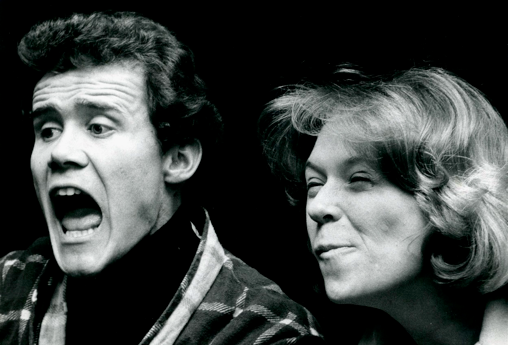 |
ACTING and PERFORMING
Performing arts and other forms of art occurring within the borders of performing have questioned and taken over the traditional theatre. I do not wish to imagine living in prehistoric times preceding these forms of art. Because my primary objective is, however, to communicate with the Finnish professional theatre in a wide field (where the main style is the traditional, “representative“ theatre), how could I outline the areas of “performing” and “acting” in this research? Are actors not always performing? Are we not all somehow performing a social role, even very consciously?
One possible way of creating differences is to start from the English way of distinguishing these areas: to act, to perform.
At the beginning of this essay On acting and not-acting, Michael Kirby says:
"To act means to feign, to simulate, to represent, to impersonate. As Happenings demonstrated, not all performing is acting (....) (Kirby:43)
(...)If the performer does something to simulate, represent, impersonate and so forth, he or she is acting(...) No emotion needs to be envolved.”(Kirby:51)
In Marvin Carlson’s book Performance: A Critical Introduction, a performance is described as follows:
...to ask what makes performing art performative, I imagine the answer would somehow suggest that these arts require the physical presence of trained or skilled human beings whose demonstration of their skill is the performance. (Carlson:5)
To perform another person is separated by Carlson from “mere” performing as follows:
(...)points to a quality of performance not involved with the display of skills but rather with a certain distance between “self” and behavior, analogous to that between an actor and the role this actor plays on stage.”(Carlson:16)
Another useful way of finding meaningful differences between the two concepts could be in the way the use of a “mask” is perceived in stage. For the performer, the mask can be one of the tools used in performing, one of the many skills the performer presents to the audience. The performer, such as an expert in Commedia dell’Arte, charms us by his/her skills in using the mask. In this context, the mask is a concrete object which is placed over the face, made partly or fully of leather and wood, and covers the face in full. The actor can use an actual concrete mask or an imagined “mark” of a “mask”. In this kind of case is a question of an attribute produced by the mask, the expression of the actor caused by the blending of the performer and the mask. The actor accepts the mask as a “visitor” instead of using it as an external tool or a narrative “stage instrument”.
However, it should be admitted at this stage that, in everyday use, a performance, performing and acting are parts of a massive semantic field, and their exhaustive definition at a useful general level is humanly impossible. I will present a few boundaries for these concepts and, above all, their stage objectives within the scope of my research and its practices.
This research outlines said acting in a play as a separate field and, in any disputes over the definition of acting, follows the “performance of another person” proposed by Marvin Carlson and “to act”/”to perform” proposed by Michael Kirby.
Sources:
- Carlson, Marvin (2004). Esitys ja performanssi – kriittinen johdatus (Performance: A Critical Introduction). Like. Otavan Kirjapaino OY. Keuruu.
- Kirby, Michael (1965). On Acting and Not-Acting. In Zarrilli, Phillip B. (1995). Acting (re) Considered, 43–58. Routledge. New York.
